A Study of Market Crises: Facts, Figures, and Economic Effects
VerifiedAdded on 2020/07/23
|54
|19361
|69
Report
AI Summary
This report provides a comprehensive analysis of major market crises from 1987 to 2011, examining their causes, facts, figures, and economic impact. It begins with an abstract defining market crises and reviewing relevant literature. The study investigates seven major crises, including Black Monday (1987), the 1990 crisis, the Russian crisis (1998), the dotcom crisis (2000), the 9/11 attacks, and the 2008 credit crunch. The research focuses on six major stock indexes (excluding China) and their performance during these crises, comparing recovery times, durations, and correlations. The methodology includes a research paradigm, approach, type, data collection and analysis, and ethical considerations. The findings highlight the commonalities and differences among indexes, particularly noting the strong correlation of European markets. The report examines the facts, figures, and causes of each crisis, including derivative securities, oil prices, corporate corruption, and easy credit conditions. The conclusion summarizes the key findings and offers recommendations for preventing future market crises, emphasizing the need for proactive measures by policymakers. The report also includes a literature review, methodology, data findings, and a section on learning reflections.
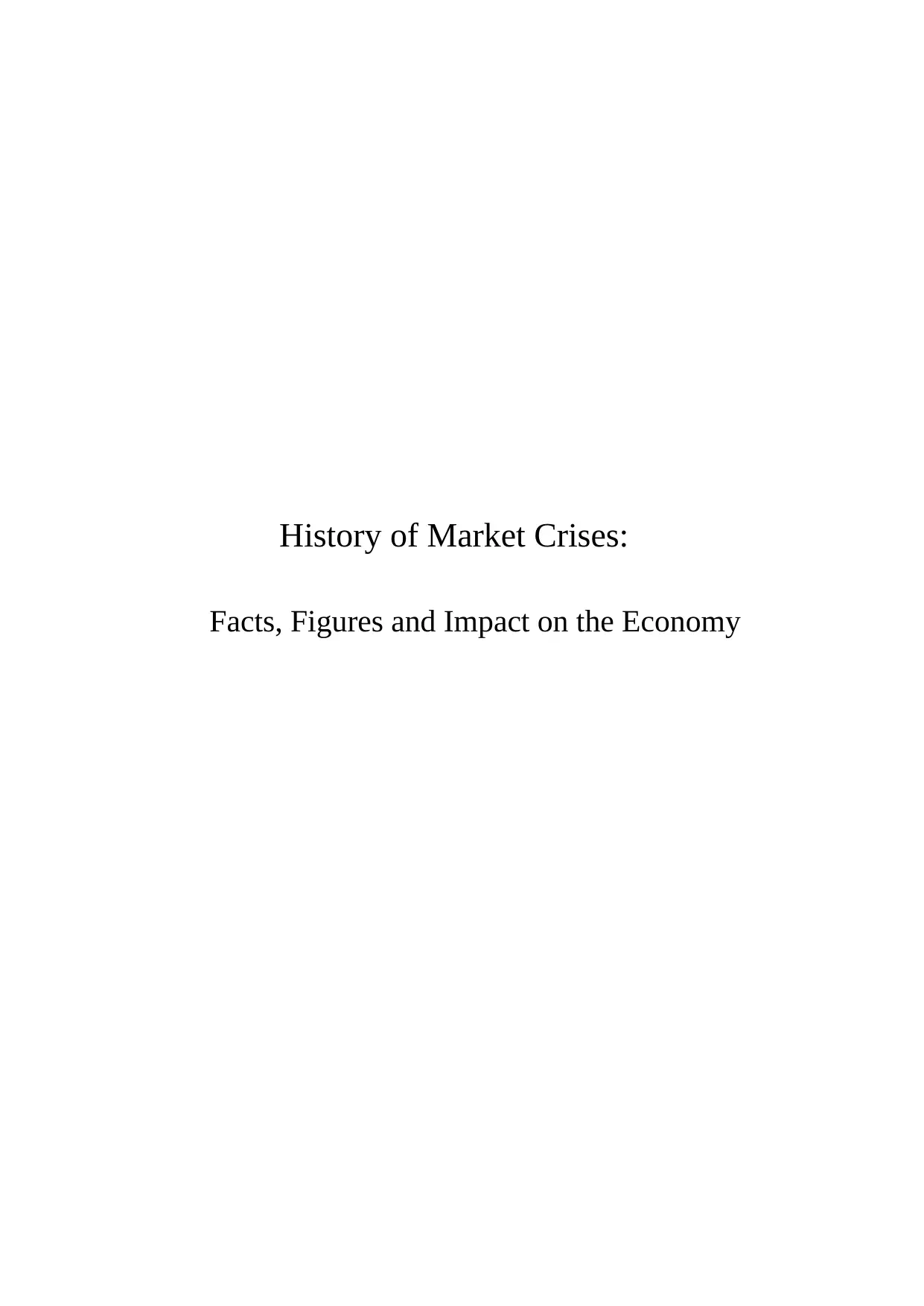
History of Market Crises:
Facts, Figures and Impact on the Economy
Facts, Figures and Impact on the Economy
Paraphrase This Document
Need a fresh take? Get an instant paraphrase of this document with our AI Paraphraser
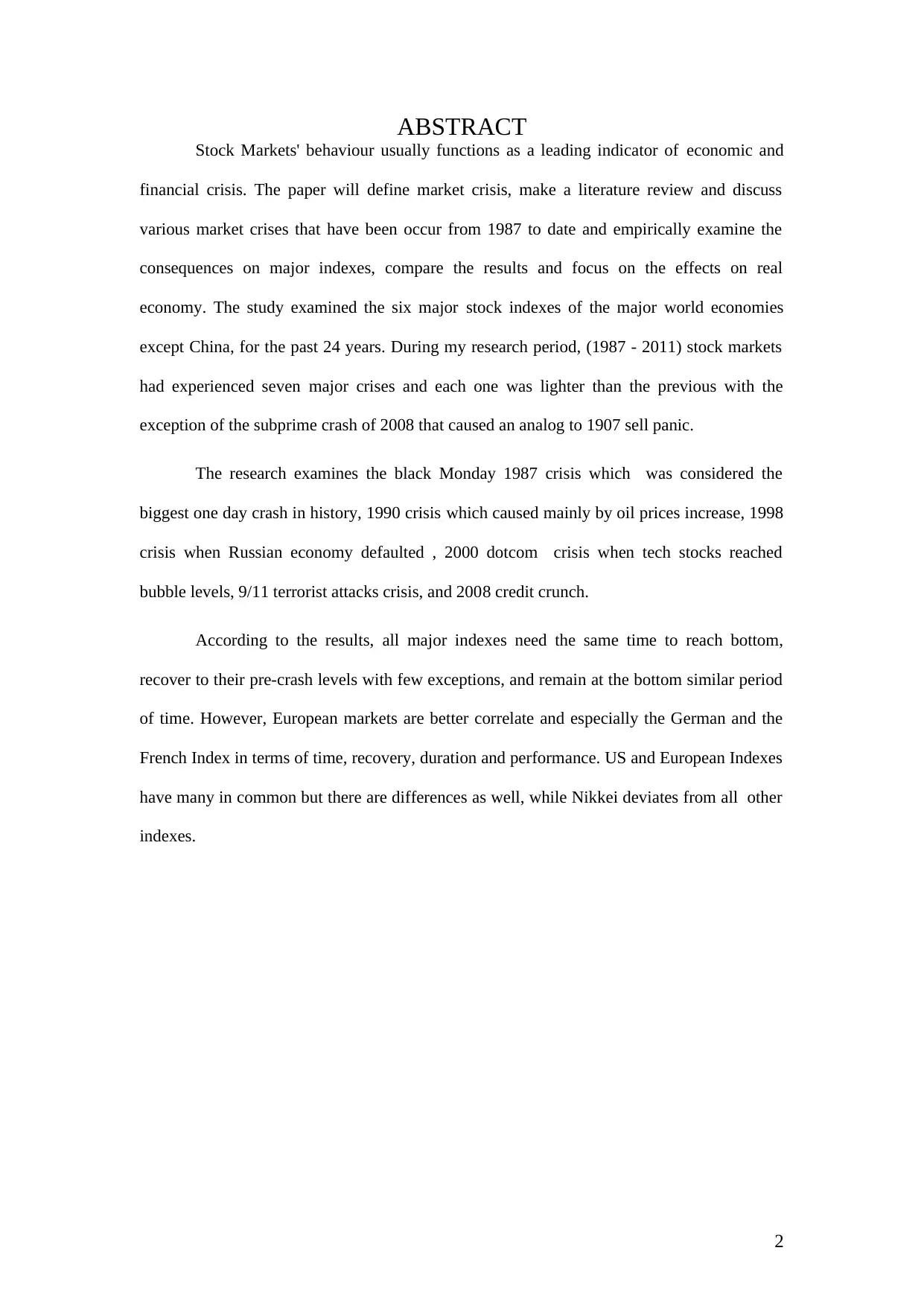
ABSTRACT
Stock Markets' behaviour usually functions as a leading indicator of economic and
financial crisis. The paper will define market crisis, make a literature review and discuss
various market crises that have been occur from 1987 to date and empirically examine the
consequences on major indexes, compare the results and focus on the effects on real
economy. The study examined the six major stock indexes of the major world economies
except China, for the past 24 years. During my research period, (1987 - 2011) stock markets
had experienced seven major crises and each one was lighter than the previous with the
exception of the subprime crash of 2008 that caused an analog to 1907 sell panic.
The research examines the black Monday 1987 crisis which was considered the
biggest one day crash in history, 1990 crisis which caused mainly by oil prices increase, 1998
crisis when Russian economy defaulted , 2000 dotcom crisis when tech stocks reached
bubble levels, 9/11 terrorist attacks crisis, and 2008 credit crunch.
According to the results, all major indexes need the same time to reach bottom,
recover to their pre-crash levels with few exceptions, and remain at the bottom similar period
of time. However, European markets are better correlate and especially the German and the
French Index in terms of time, recovery, duration and performance. US and European Indexes
have many in common but there are differences as well, while Nikkei deviates from all other
indexes.
2
Stock Markets' behaviour usually functions as a leading indicator of economic and
financial crisis. The paper will define market crisis, make a literature review and discuss
various market crises that have been occur from 1987 to date and empirically examine the
consequences on major indexes, compare the results and focus on the effects on real
economy. The study examined the six major stock indexes of the major world economies
except China, for the past 24 years. During my research period, (1987 - 2011) stock markets
had experienced seven major crises and each one was lighter than the previous with the
exception of the subprime crash of 2008 that caused an analog to 1907 sell panic.
The research examines the black Monday 1987 crisis which was considered the
biggest one day crash in history, 1990 crisis which caused mainly by oil prices increase, 1998
crisis when Russian economy defaulted , 2000 dotcom crisis when tech stocks reached
bubble levels, 9/11 terrorist attacks crisis, and 2008 credit crunch.
According to the results, all major indexes need the same time to reach bottom,
recover to their pre-crash levels with few exceptions, and remain at the bottom similar period
of time. However, European markets are better correlate and especially the German and the
French Index in terms of time, recovery, duration and performance. US and European Indexes
have many in common but there are differences as well, while Nikkei deviates from all other
indexes.
2
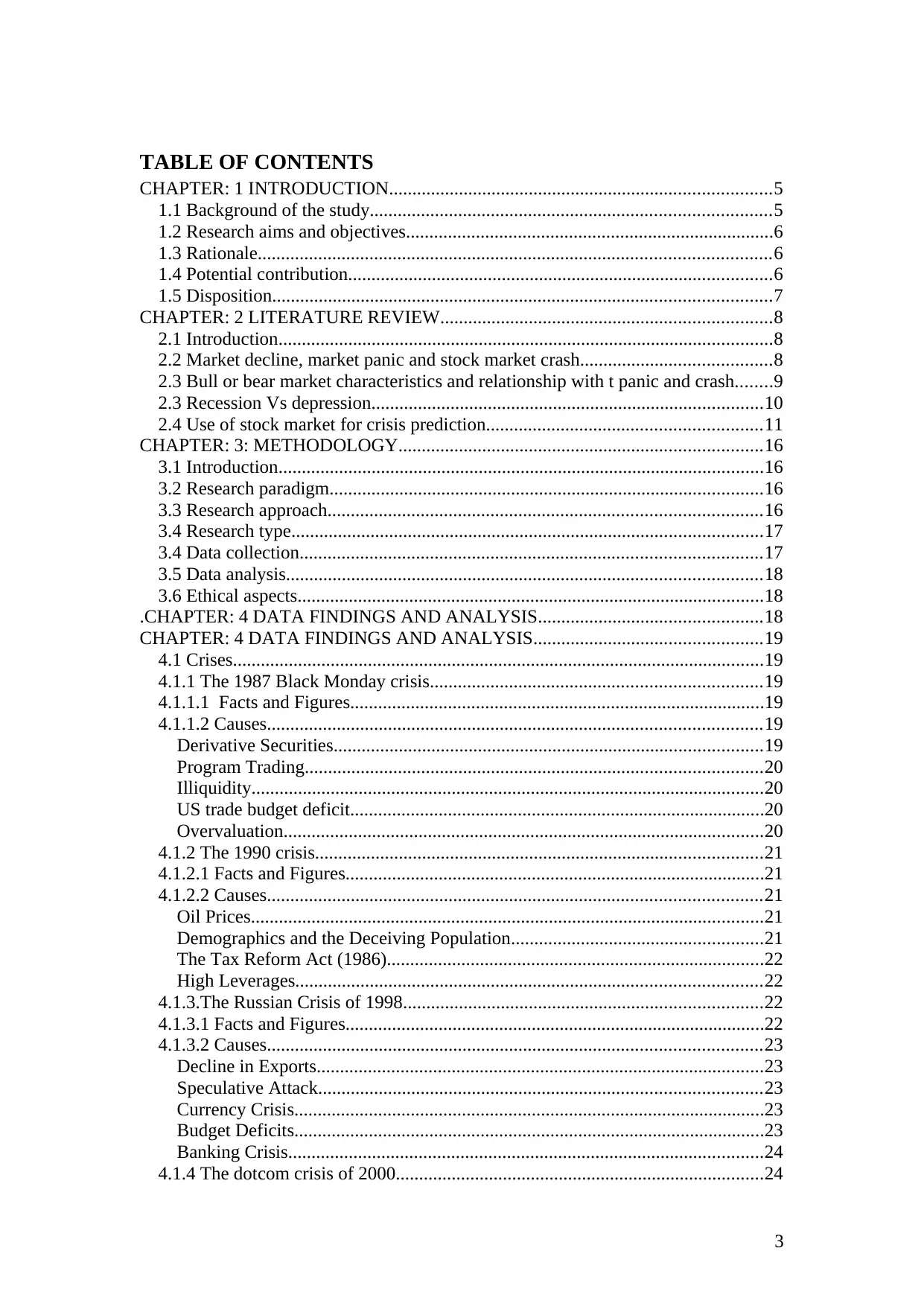
TABLE OF CONTENTS
CHAPTER: 1 INTRODUCTION..................................................................................5
1.1 Background of the study......................................................................................5
1.2 Research aims and objectives...............................................................................6
1.3 Rationale..............................................................................................................6
1.4 Potential contribution...........................................................................................6
1.5 Disposition...........................................................................................................7
CHAPTER: 2 LITERATURE REVIEW.......................................................................8
2.1 Introduction..........................................................................................................8
2.2 Market decline, market panic and stock market crash.........................................8
2.3 Bull or bear market characteristics and relationship with t panic and crash........9
2.3 Recession Vs depression....................................................................................10
2.4 Use of stock market for crisis prediction...........................................................11
CHAPTER: 3: METHODOLOGY..............................................................................16
3.1 Introduction........................................................................................................16
3.2 Research paradigm.............................................................................................16
3.3 Research approach.............................................................................................16
3.4 Research type.....................................................................................................17
3.4 Data collection...................................................................................................17
3.5 Data analysis......................................................................................................18
3.6 Ethical aspects....................................................................................................18
.CHAPTER: 4 DATA FINDINGS AND ANALYSIS................................................18
CHAPTER: 4 DATA FINDINGS AND ANALYSIS.................................................19
4.1 Crises..................................................................................................................19
4.1.1 The 1987 Black Monday crisis.......................................................................19
4.1.1.1 Facts and Figures.........................................................................................19
4.1.1.2 Causes..........................................................................................................19
Derivative Securities............................................................................................19
Program Trading..................................................................................................20
Illiquidity..............................................................................................................20
US trade budget deficit.........................................................................................20
Overvaluation.......................................................................................................20
4.1.2 The 1990 crisis................................................................................................21
4.1.2.1 Facts and Figures..........................................................................................21
4.1.2.2 Causes..........................................................................................................21
Oil Prices..............................................................................................................21
Demographics and the Deceiving Population......................................................21
The Tax Reform Act (1986).................................................................................22
High Leverages....................................................................................................22
4.1.3.The Russian Crisis of 1998.............................................................................22
4.1.3.1 Facts and Figures..........................................................................................22
4.1.3.2 Causes..........................................................................................................23
Decline in Exports................................................................................................23
Speculative Attack...............................................................................................23
Currency Crisis.....................................................................................................23
Budget Deficits.....................................................................................................23
Banking Crisis......................................................................................................24
4.1.4 The dotcom crisis of 2000...............................................................................24
3
CHAPTER: 1 INTRODUCTION..................................................................................5
1.1 Background of the study......................................................................................5
1.2 Research aims and objectives...............................................................................6
1.3 Rationale..............................................................................................................6
1.4 Potential contribution...........................................................................................6
1.5 Disposition...........................................................................................................7
CHAPTER: 2 LITERATURE REVIEW.......................................................................8
2.1 Introduction..........................................................................................................8
2.2 Market decline, market panic and stock market crash.........................................8
2.3 Bull or bear market characteristics and relationship with t panic and crash........9
2.3 Recession Vs depression....................................................................................10
2.4 Use of stock market for crisis prediction...........................................................11
CHAPTER: 3: METHODOLOGY..............................................................................16
3.1 Introduction........................................................................................................16
3.2 Research paradigm.............................................................................................16
3.3 Research approach.............................................................................................16
3.4 Research type.....................................................................................................17
3.4 Data collection...................................................................................................17
3.5 Data analysis......................................................................................................18
3.6 Ethical aspects....................................................................................................18
.CHAPTER: 4 DATA FINDINGS AND ANALYSIS................................................18
CHAPTER: 4 DATA FINDINGS AND ANALYSIS.................................................19
4.1 Crises..................................................................................................................19
4.1.1 The 1987 Black Monday crisis.......................................................................19
4.1.1.1 Facts and Figures.........................................................................................19
4.1.1.2 Causes..........................................................................................................19
Derivative Securities............................................................................................19
Program Trading..................................................................................................20
Illiquidity..............................................................................................................20
US trade budget deficit.........................................................................................20
Overvaluation.......................................................................................................20
4.1.2 The 1990 crisis................................................................................................21
4.1.2.1 Facts and Figures..........................................................................................21
4.1.2.2 Causes..........................................................................................................21
Oil Prices..............................................................................................................21
Demographics and the Deceiving Population......................................................21
The Tax Reform Act (1986).................................................................................22
High Leverages....................................................................................................22
4.1.3.The Russian Crisis of 1998.............................................................................22
4.1.3.1 Facts and Figures..........................................................................................22
4.1.3.2 Causes..........................................................................................................23
Decline in Exports................................................................................................23
Speculative Attack...............................................................................................23
Currency Crisis.....................................................................................................23
Budget Deficits.....................................................................................................23
Banking Crisis......................................................................................................24
4.1.4 The dotcom crisis of 2000...............................................................................24
3
⊘ This is a preview!⊘
Do you want full access?
Subscribe today to unlock all pages.

Trusted by 1+ million students worldwide
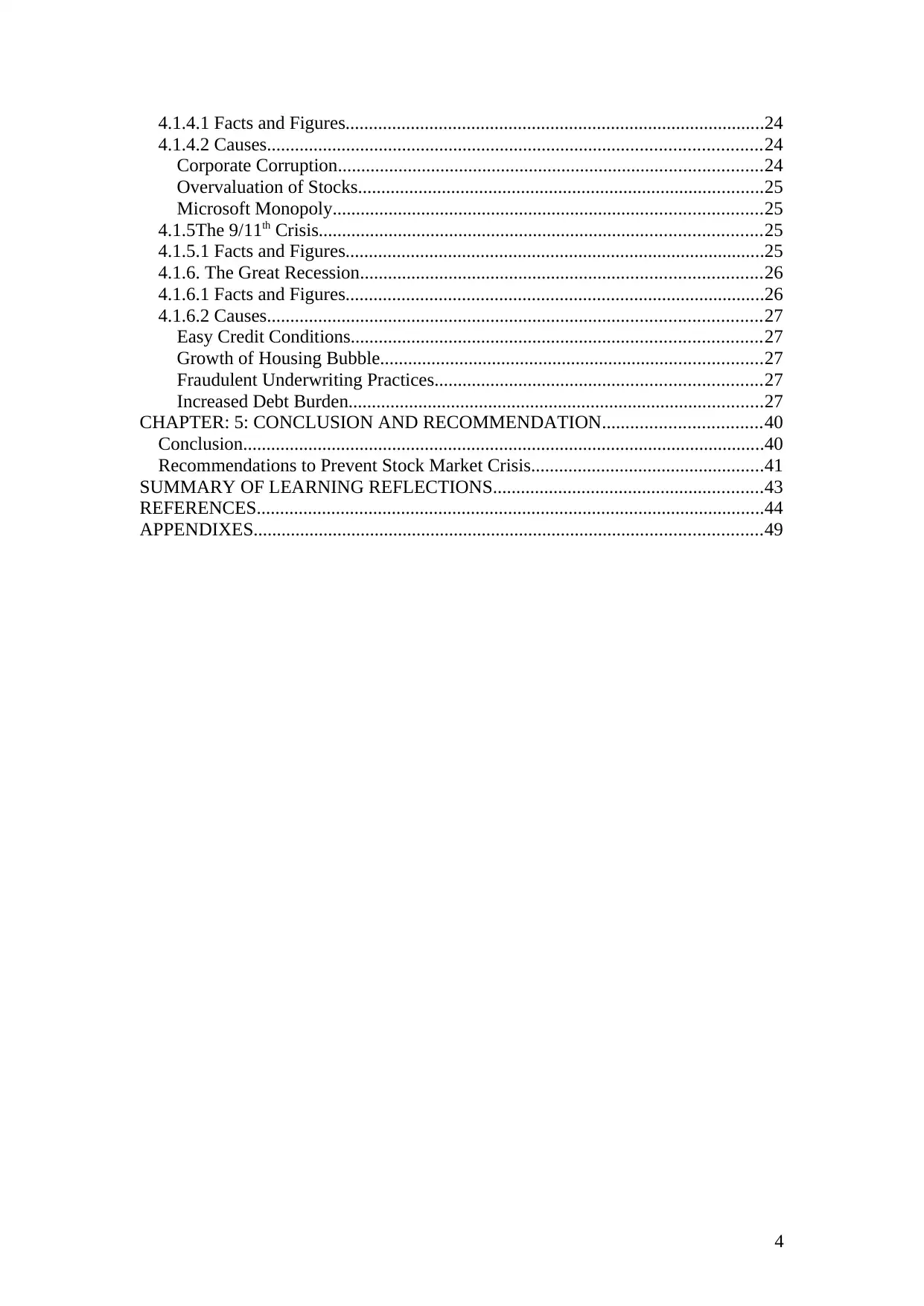
4.1.4.1 Facts and Figures..........................................................................................24
4.1.4.2 Causes..........................................................................................................24
Corporate Corruption...........................................................................................24
Overvaluation of Stocks.......................................................................................25
Microsoft Monopoly............................................................................................25
4.1.5The 9/11th Crisis...............................................................................................25
4.1.5.1 Facts and Figures..........................................................................................25
4.1.6. The Great Recession......................................................................................26
4.1.6.1 Facts and Figures..........................................................................................26
4.1.6.2 Causes..........................................................................................................27
Easy Credit Conditions........................................................................................27
Growth of Housing Bubble..................................................................................27
Fraudulent Underwriting Practices......................................................................27
Increased Debt Burden.........................................................................................27
CHAPTER: 5: CONCLUSION AND RECOMMENDATION..................................40
Conclusion................................................................................................................40
Recommendations to Prevent Stock Market Crisis..................................................41
SUMMARY OF LEARNING REFLECTIONS..........................................................43
REFERENCES.............................................................................................................44
APPENDIXES.............................................................................................................49
4
4.1.4.2 Causes..........................................................................................................24
Corporate Corruption...........................................................................................24
Overvaluation of Stocks.......................................................................................25
Microsoft Monopoly............................................................................................25
4.1.5The 9/11th Crisis...............................................................................................25
4.1.5.1 Facts and Figures..........................................................................................25
4.1.6. The Great Recession......................................................................................26
4.1.6.1 Facts and Figures..........................................................................................26
4.1.6.2 Causes..........................................................................................................27
Easy Credit Conditions........................................................................................27
Growth of Housing Bubble..................................................................................27
Fraudulent Underwriting Practices......................................................................27
Increased Debt Burden.........................................................................................27
CHAPTER: 5: CONCLUSION AND RECOMMENDATION..................................40
Conclusion................................................................................................................40
Recommendations to Prevent Stock Market Crisis..................................................41
SUMMARY OF LEARNING REFLECTIONS..........................................................43
REFERENCES.............................................................................................................44
APPENDIXES.............................................................................................................49
4
Paraphrase This Document
Need a fresh take? Get an instant paraphrase of this document with our AI Paraphraser
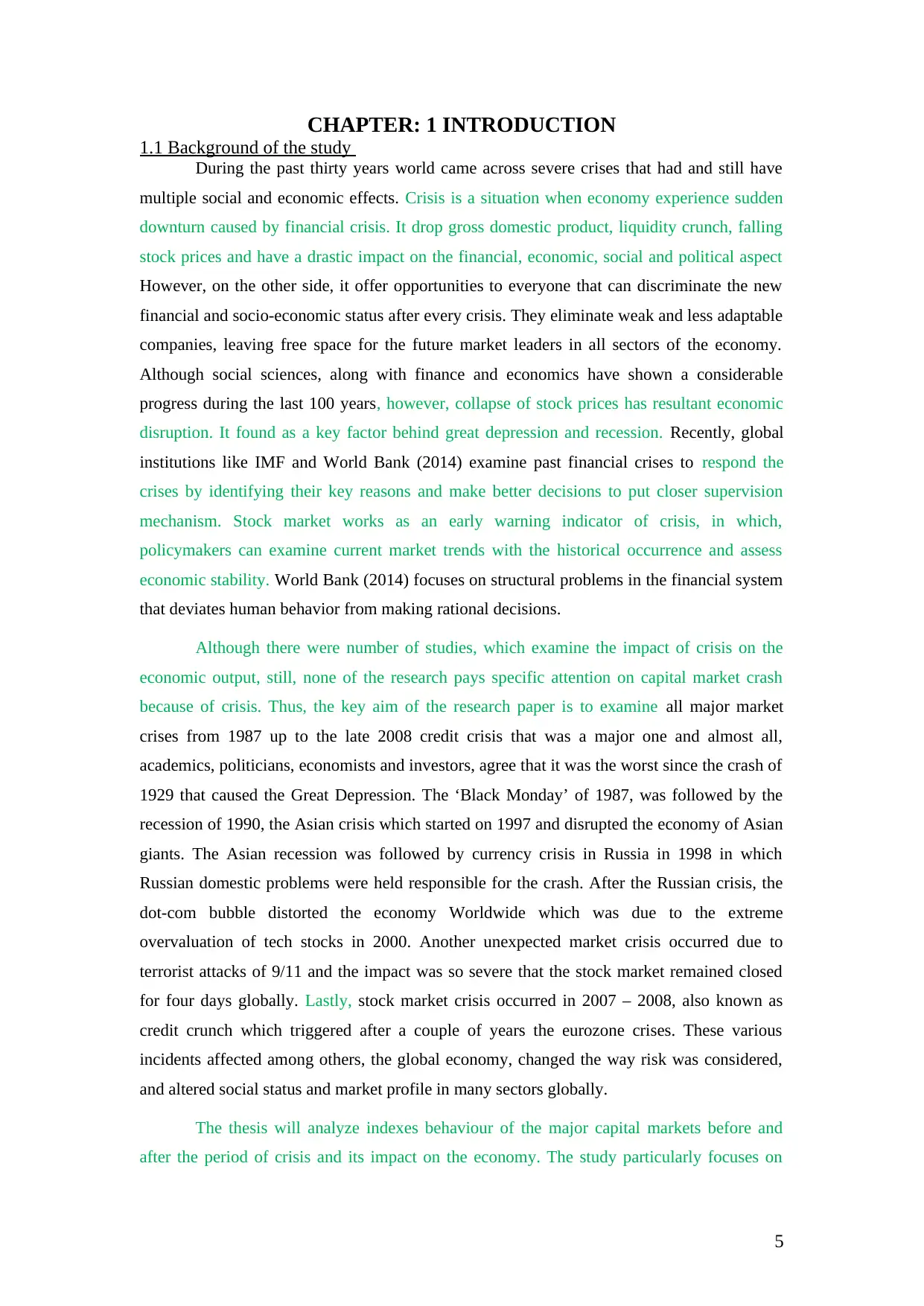
CHAPTER: 1 INTRODUCTION
1.1 Background of the study
During the past thirty years world came across severe crises that had and still have
multiple social and economic effects. Crisis is a situation when economy experience sudden
downturn caused by financial crisis. It drop gross domestic product, liquidity crunch, falling
stock prices and have a drastic impact on the financial, economic, social and political aspect
However, on the other side, it offer opportunities to everyone that can discriminate the new
financial and socio-economic status after every crisis. They eliminate weak and less adaptable
companies, leaving free space for the future market leaders in all sectors of the economy.
Although social sciences, along with finance and economics have shown a considerable
progress during the last 100 years, however, collapse of stock prices has resultant economic
disruption. It found as a key factor behind great depression and recession. Recently, global
institutions like IMF and World Bank (2014) examine past financial crises to respond the
crises by identifying their key reasons and make better decisions to put closer supervision
mechanism. Stock market works as an early warning indicator of crisis, in which,
policymakers can examine current market trends with the historical occurrence and assess
economic stability. World Bank (2014) focuses on structural problems in the financial system
that deviates human behavior from making rational decisions.
Although there were number of studies, which examine the impact of crisis on the
economic output, still, none of the research pays specific attention on capital market crash
because of crisis. Thus, the key aim of the research paper is to examine all major market
crises from 1987 up to the late 2008 credit crisis that was a major one and almost all,
academics, politicians, economists and investors, agree that it was the worst since the crash of
1929 that caused the Great Depression. The ‘Black Monday’ of 1987, was followed by the
recession of 1990, the Asian crisis which started on 1997 and disrupted the economy of Asian
giants. The Asian recession was followed by currency crisis in Russia in 1998 in which
Russian domestic problems were held responsible for the crash. After the Russian crisis, the
dot-com bubble distorted the economy Worldwide which was due to the extreme
overvaluation of tech stocks in 2000. Another unexpected market crisis occurred due to
terrorist attacks of 9/11 and the impact was so severe that the stock market remained closed
for four days globally. Lastly, stock market crisis occurred in 2007 – 2008, also known as
credit crunch which triggered after a couple of years the eurozone crises. These various
incidents affected among others, the global economy, changed the way risk was considered,
and altered social status and market profile in many sectors globally.
The thesis will analyze indexes behaviour of the major capital markets before and
after the period of crisis and its impact on the economy. The study particularly focuses on
5
1.1 Background of the study
During the past thirty years world came across severe crises that had and still have
multiple social and economic effects. Crisis is a situation when economy experience sudden
downturn caused by financial crisis. It drop gross domestic product, liquidity crunch, falling
stock prices and have a drastic impact on the financial, economic, social and political aspect
However, on the other side, it offer opportunities to everyone that can discriminate the new
financial and socio-economic status after every crisis. They eliminate weak and less adaptable
companies, leaving free space for the future market leaders in all sectors of the economy.
Although social sciences, along with finance and economics have shown a considerable
progress during the last 100 years, however, collapse of stock prices has resultant economic
disruption. It found as a key factor behind great depression and recession. Recently, global
institutions like IMF and World Bank (2014) examine past financial crises to respond the
crises by identifying their key reasons and make better decisions to put closer supervision
mechanism. Stock market works as an early warning indicator of crisis, in which,
policymakers can examine current market trends with the historical occurrence and assess
economic stability. World Bank (2014) focuses on structural problems in the financial system
that deviates human behavior from making rational decisions.
Although there were number of studies, which examine the impact of crisis on the
economic output, still, none of the research pays specific attention on capital market crash
because of crisis. Thus, the key aim of the research paper is to examine all major market
crises from 1987 up to the late 2008 credit crisis that was a major one and almost all,
academics, politicians, economists and investors, agree that it was the worst since the crash of
1929 that caused the Great Depression. The ‘Black Monday’ of 1987, was followed by the
recession of 1990, the Asian crisis which started on 1997 and disrupted the economy of Asian
giants. The Asian recession was followed by currency crisis in Russia in 1998 in which
Russian domestic problems were held responsible for the crash. After the Russian crisis, the
dot-com bubble distorted the economy Worldwide which was due to the extreme
overvaluation of tech stocks in 2000. Another unexpected market crisis occurred due to
terrorist attacks of 9/11 and the impact was so severe that the stock market remained closed
for four days globally. Lastly, stock market crisis occurred in 2007 – 2008, also known as
credit crunch which triggered after a couple of years the eurozone crises. These various
incidents affected among others, the global economy, changed the way risk was considered,
and altered social status and market profile in many sectors globally.
The thesis will analyze indexes behaviour of the major capital markets before and
after the period of crisis and its impact on the economy. The study particularly focuses on
5
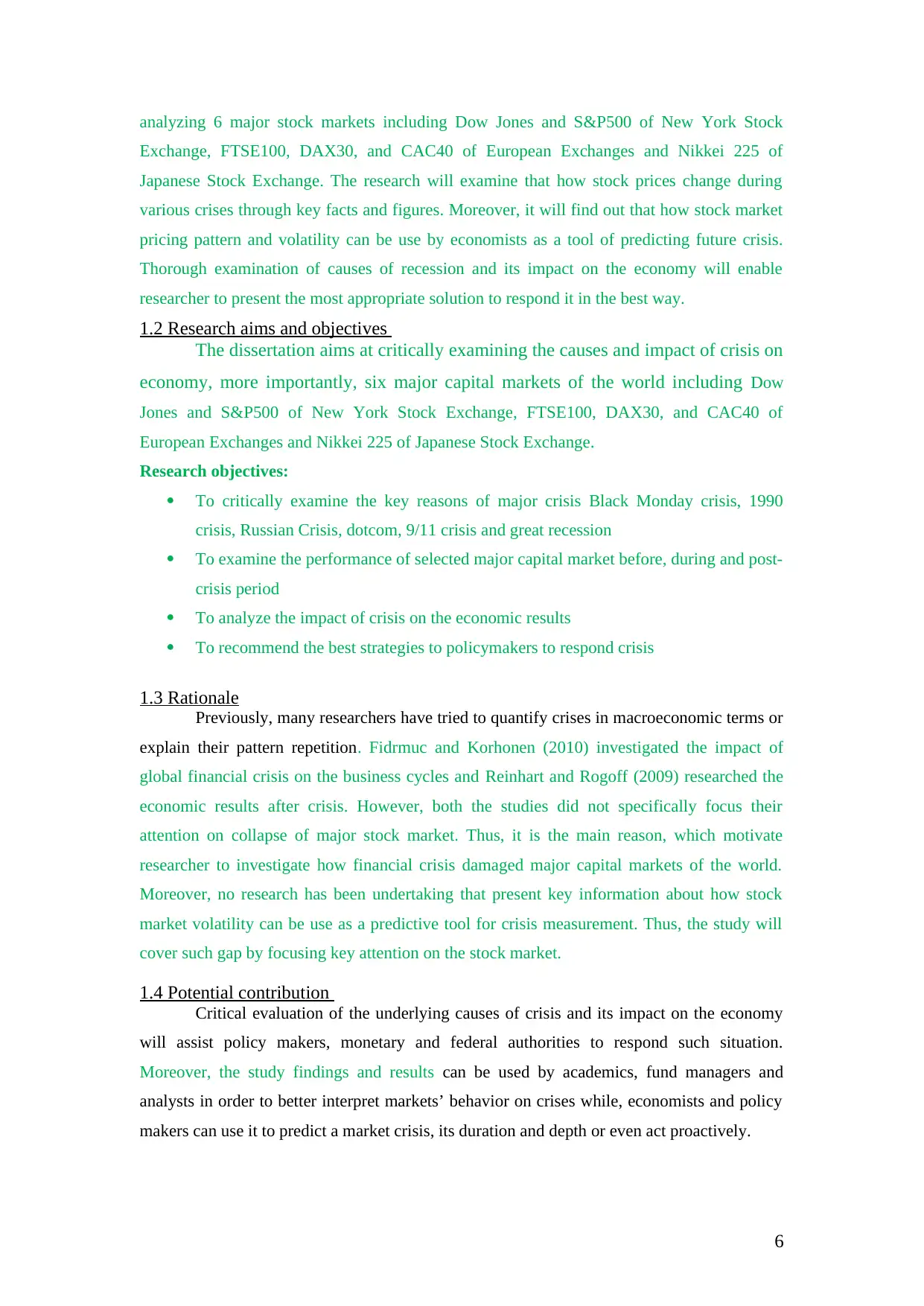
analyzing 6 major stock markets including Dow Jones and S&P500 of New York Stock
Exchange, FTSE100, DAX30, and CAC40 of European Exchanges and Nikkei 225 of
Japanese Stock Exchange. The research will examine that how stock prices change during
various crises through key facts and figures. Moreover, it will find out that how stock market
pricing pattern and volatility can be use by economists as a tool of predicting future crisis.
Thorough examination of causes of recession and its impact on the economy will enable
researcher to present the most appropriate solution to respond it in the best way.
1.2 Research aims and objectives
The dissertation aims at critically examining the causes and impact of crisis on
economy, more importantly, six major capital markets of the world including Dow
Jones and S&P500 of New York Stock Exchange, FTSE100, DAX30, and CAC40 of
European Exchanges and Nikkei 225 of Japanese Stock Exchange.
Research objectives:
To critically examine the key reasons of major crisis Black Monday crisis, 1990
crisis, Russian Crisis, dotcom, 9/11 crisis and great recession
To examine the performance of selected major capital market before, during and post-
crisis period
To analyze the impact of crisis on the economic results
To recommend the best strategies to policymakers to respond crisis
1.3 Rationale
Previously, many researchers have tried to quantify crises in macroeconomic terms or
explain their pattern repetition. Fidrmuc and Korhonen (2010) investigated the impact of
global financial crisis on the business cycles and Reinhart and Rogoff (2009) researched the
economic results after crisis. However, both the studies did not specifically focus their
attention on collapse of major stock market. Thus, it is the main reason, which motivate
researcher to investigate how financial crisis damaged major capital markets of the world.
Moreover, no research has been undertaking that present key information about how stock
market volatility can be use as a predictive tool for crisis measurement. Thus, the study will
cover such gap by focusing key attention on the stock market.
1.4 Potential contribution
Critical evaluation of the underlying causes of crisis and its impact on the economy
will assist policy makers, monetary and federal authorities to respond such situation.
Moreover, the study findings and results can be used by academics, fund managers and
analysts in order to better interpret markets’ behavior on crises while, economists and policy
makers can use it to predict a market crisis, its duration and depth or even act proactively.
6
Exchange, FTSE100, DAX30, and CAC40 of European Exchanges and Nikkei 225 of
Japanese Stock Exchange. The research will examine that how stock prices change during
various crises through key facts and figures. Moreover, it will find out that how stock market
pricing pattern and volatility can be use by economists as a tool of predicting future crisis.
Thorough examination of causes of recession and its impact on the economy will enable
researcher to present the most appropriate solution to respond it in the best way.
1.2 Research aims and objectives
The dissertation aims at critically examining the causes and impact of crisis on
economy, more importantly, six major capital markets of the world including Dow
Jones and S&P500 of New York Stock Exchange, FTSE100, DAX30, and CAC40 of
European Exchanges and Nikkei 225 of Japanese Stock Exchange.
Research objectives:
To critically examine the key reasons of major crisis Black Monday crisis, 1990
crisis, Russian Crisis, dotcom, 9/11 crisis and great recession
To examine the performance of selected major capital market before, during and post-
crisis period
To analyze the impact of crisis on the economic results
To recommend the best strategies to policymakers to respond crisis
1.3 Rationale
Previously, many researchers have tried to quantify crises in macroeconomic terms or
explain their pattern repetition. Fidrmuc and Korhonen (2010) investigated the impact of
global financial crisis on the business cycles and Reinhart and Rogoff (2009) researched the
economic results after crisis. However, both the studies did not specifically focus their
attention on collapse of major stock market. Thus, it is the main reason, which motivate
researcher to investigate how financial crisis damaged major capital markets of the world.
Moreover, no research has been undertaking that present key information about how stock
market volatility can be use as a predictive tool for crisis measurement. Thus, the study will
cover such gap by focusing key attention on the stock market.
1.4 Potential contribution
Critical evaluation of the underlying causes of crisis and its impact on the economy
will assist policy makers, monetary and federal authorities to respond such situation.
Moreover, the study findings and results can be used by academics, fund managers and
analysts in order to better interpret markets’ behavior on crises while, economists and policy
makers can use it to predict a market crisis, its duration and depth or even act proactively.
6
⊘ This is a preview!⊘
Do you want full access?
Subscribe today to unlock all pages.

Trusted by 1+ million students worldwide
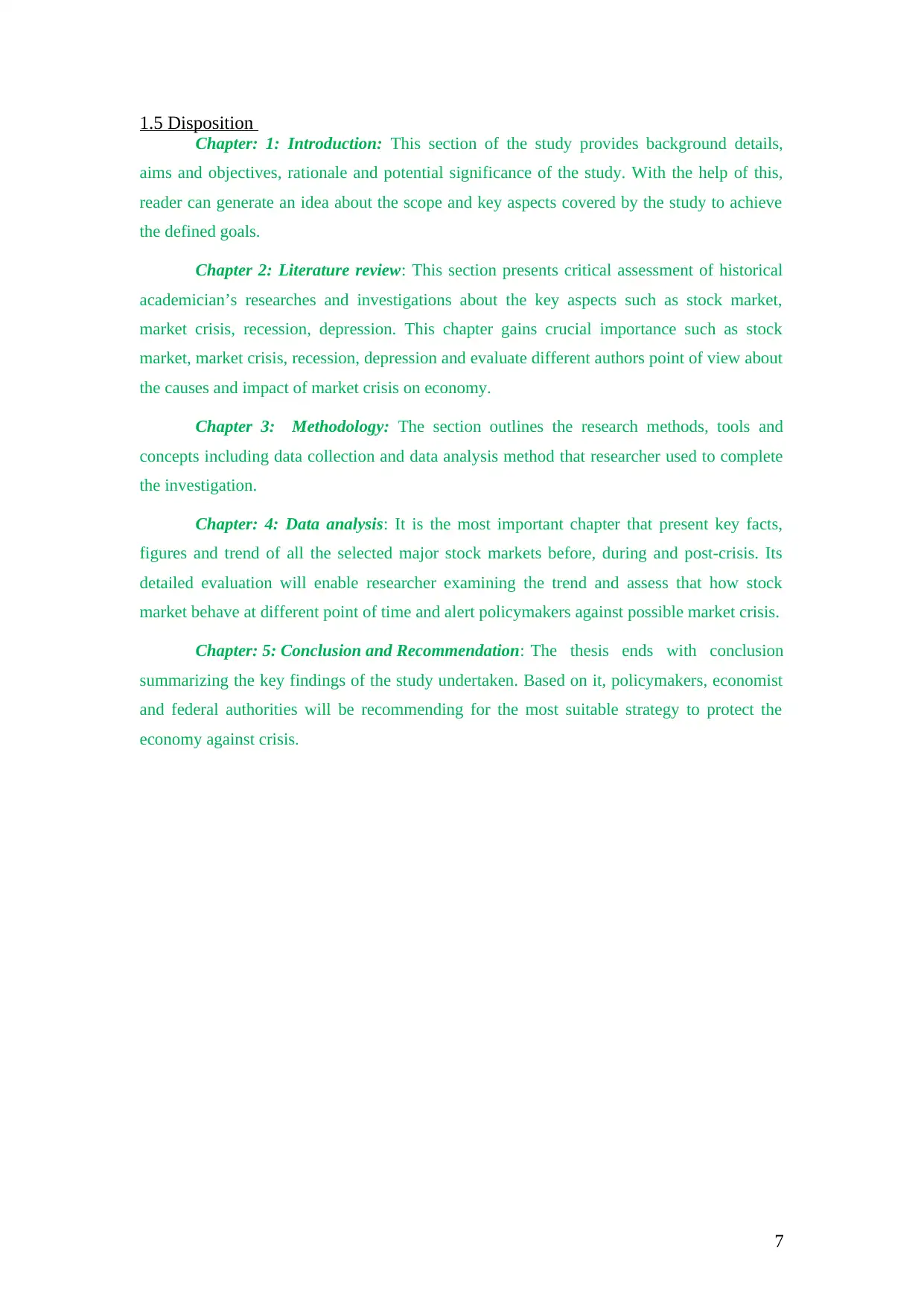
1.5 Disposition
Chapter: 1: Introduction: This section of the study provides background details,
aims and objectives, rationale and potential significance of the study. With the help of this,
reader can generate an idea about the scope and key aspects covered by the study to achieve
the defined goals.
Chapter 2: Literature review: This section presents critical assessment of historical
academician’s researches and investigations about the key aspects such as stock market,
market crisis, recession, depression. This chapter gains crucial importance such as stock
market, market crisis, recession, depression and evaluate different authors point of view about
the causes and impact of market crisis on economy.
Chapter 3: Methodology: The section outlines the research methods, tools and
concepts including data collection and data analysis method that researcher used to complete
the investigation.
Chapter: 4: Data analysis: It is the most important chapter that present key facts,
figures and trend of all the selected major stock markets before, during and post-crisis. Its
detailed evaluation will enable researcher examining the trend and assess that how stock
market behave at different point of time and alert policymakers against possible market crisis.
Chapter: 5: Conclusion and Recommendation: The thesis ends with conclusion
summarizing the key findings of the study undertaken. Based on it, policymakers, economist
and federal authorities will be recommending for the most suitable strategy to protect the
economy against crisis.
7
Chapter: 1: Introduction: This section of the study provides background details,
aims and objectives, rationale and potential significance of the study. With the help of this,
reader can generate an idea about the scope and key aspects covered by the study to achieve
the defined goals.
Chapter 2: Literature review: This section presents critical assessment of historical
academician’s researches and investigations about the key aspects such as stock market,
market crisis, recession, depression. This chapter gains crucial importance such as stock
market, market crisis, recession, depression and evaluate different authors point of view about
the causes and impact of market crisis on economy.
Chapter 3: Methodology: The section outlines the research methods, tools and
concepts including data collection and data analysis method that researcher used to complete
the investigation.
Chapter: 4: Data analysis: It is the most important chapter that present key facts,
figures and trend of all the selected major stock markets before, during and post-crisis. Its
detailed evaluation will enable researcher examining the trend and assess that how stock
market behave at different point of time and alert policymakers against possible market crisis.
Chapter: 5: Conclusion and Recommendation: The thesis ends with conclusion
summarizing the key findings of the study undertaken. Based on it, policymakers, economist
and federal authorities will be recommending for the most suitable strategy to protect the
economy against crisis.
7
Paraphrase This Document
Need a fresh take? Get an instant paraphrase of this document with our AI Paraphraser
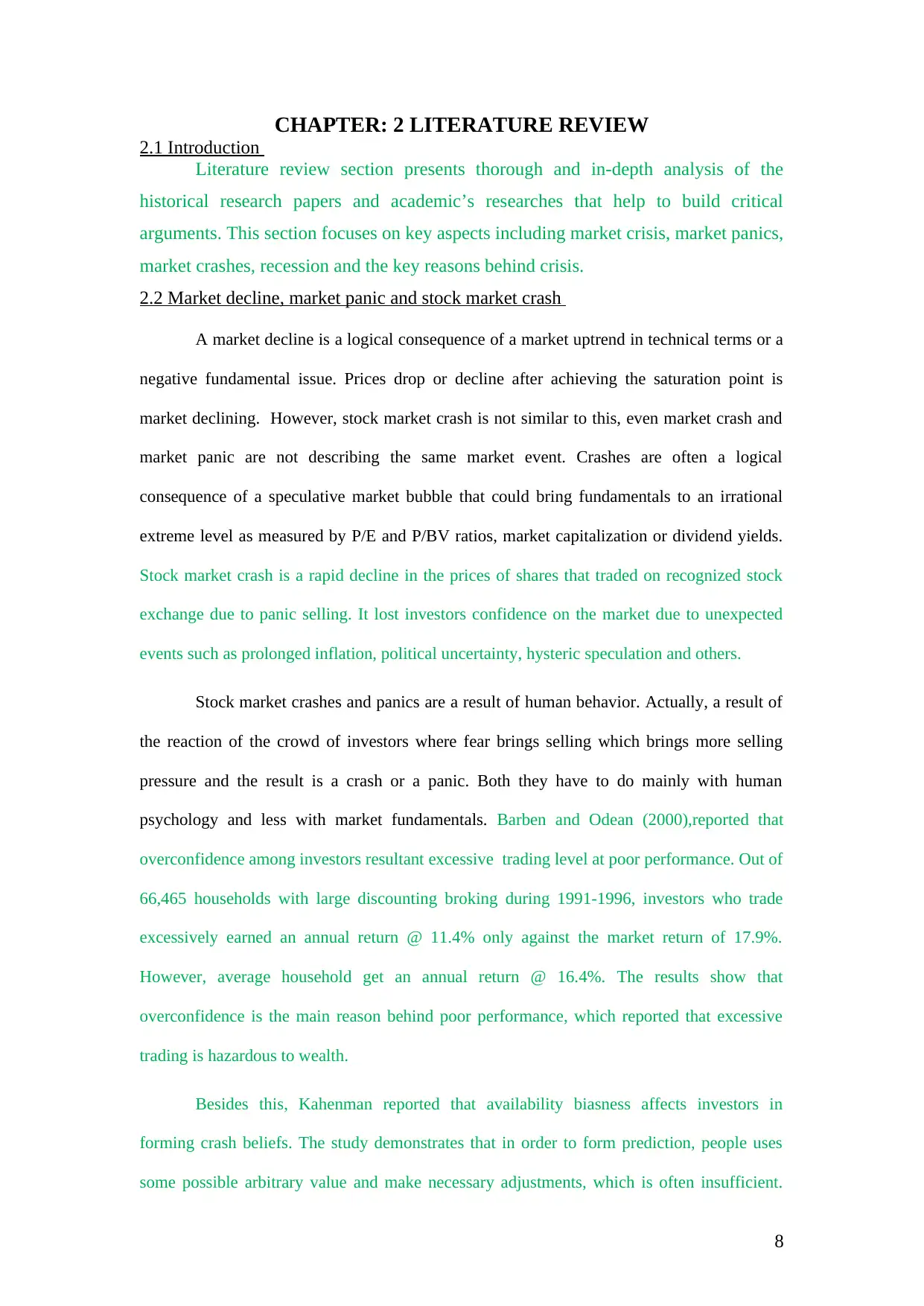
CHAPTER: 2 LITERATURE REVIEW
2.1 Introduction
Literature review section presents thorough and in-depth analysis of the
historical research papers and academic’s researches that help to build critical
arguments. This section focuses on key aspects including market crisis, market panics,
market crashes, recession and the key reasons behind crisis.
2.2 Market decline, market panic and stock market crash
A market decline is a logical consequence of a market uptrend in technical terms or a
negative fundamental issue. Prices drop or decline after achieving the saturation point is
market declining. However, stock market crash is not similar to this, even market crash and
market panic are not describing the same market event. Crashes are often a logical
consequence of a speculative market bubble that could bring fundamentals to an irrational
extreme level as measured by P/E and P/BV ratios, market capitalization or dividend yields.
Stock market crash is a rapid decline in the prices of shares that traded on recognized stock
exchange due to panic selling. It lost investors confidence on the market due to unexpected
events such as prolonged inflation, political uncertainty, hysteric speculation and others.
Stock market crashes and panics are a result of human behavior. Actually, a result of
the reaction of the crowd of investors where fear brings selling which brings more selling
pressure and the result is a crash or a panic. Both they have to do mainly with human
psychology and less with market fundamentals. Barben and Odean (2000),reported that
overconfidence among investors resultant excessive trading level at poor performance. Out of
66,465 households with large discounting broking during 1991-1996, investors who trade
excessively earned an annual return @ 11.4% only against the market return of 17.9%.
However, average household get an annual return @ 16.4%. The results show that
overconfidence is the main reason behind poor performance, which reported that excessive
trading is hazardous to wealth.
Besides this, Kahenman reported that availability biasness affects investors in
forming crash beliefs. The study demonstrates that in order to form prediction, people uses
some possible arbitrary value and make necessary adjustments, which is often insufficient.
8
2.1 Introduction
Literature review section presents thorough and in-depth analysis of the
historical research papers and academic’s researches that help to build critical
arguments. This section focuses on key aspects including market crisis, market panics,
market crashes, recession and the key reasons behind crisis.
2.2 Market decline, market panic and stock market crash
A market decline is a logical consequence of a market uptrend in technical terms or a
negative fundamental issue. Prices drop or decline after achieving the saturation point is
market declining. However, stock market crash is not similar to this, even market crash and
market panic are not describing the same market event. Crashes are often a logical
consequence of a speculative market bubble that could bring fundamentals to an irrational
extreme level as measured by P/E and P/BV ratios, market capitalization or dividend yields.
Stock market crash is a rapid decline in the prices of shares that traded on recognized stock
exchange due to panic selling. It lost investors confidence on the market due to unexpected
events such as prolonged inflation, political uncertainty, hysteric speculation and others.
Stock market crashes and panics are a result of human behavior. Actually, a result of
the reaction of the crowd of investors where fear brings selling which brings more selling
pressure and the result is a crash or a panic. Both they have to do mainly with human
psychology and less with market fundamentals. Barben and Odean (2000),reported that
overconfidence among investors resultant excessive trading level at poor performance. Out of
66,465 households with large discounting broking during 1991-1996, investors who trade
excessively earned an annual return @ 11.4% only against the market return of 17.9%.
However, average household get an annual return @ 16.4%. The results show that
overconfidence is the main reason behind poor performance, which reported that excessive
trading is hazardous to wealth.
Besides this, Kahenman reported that availability biasness affects investors in
forming crash beliefs. The study demonstrates that in order to form prediction, people uses
some possible arbitrary value and make necessary adjustments, which is often insufficient.
8
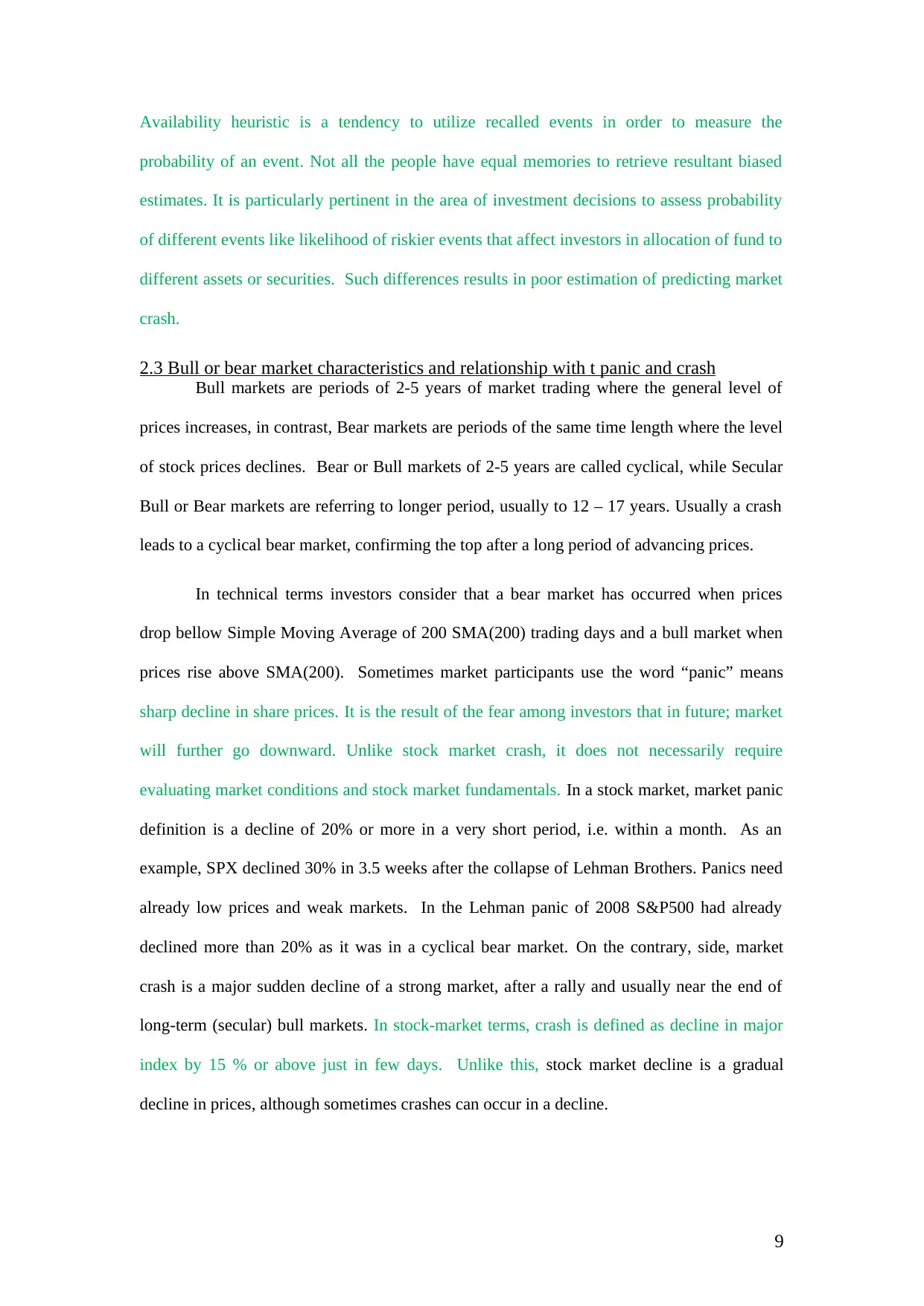
Availability heuristic is a tendency to utilize recalled events in order to measure the
probability of an event. Not all the people have equal memories to retrieve resultant biased
estimates. It is particularly pertinent in the area of investment decisions to assess probability
of different events like likelihood of riskier events that affect investors in allocation of fund to
different assets or securities. Such differences results in poor estimation of predicting market
crash.
2.3 Bull or bear market characteristics and relationship with t panic and crash
Bull markets are periods of 2-5 years of market trading where the general level of
prices increases, in contrast, Bear markets are periods of the same time length where the level
of stock prices declines. Bear or Bull markets of 2-5 years are called cyclical, while Secular
Bull or Bear markets are referring to longer period, usually to 12 – 17 years. Usually a crash
leads to a cyclical bear market, confirming the top after a long period of advancing prices.
In technical terms investors consider that a bear market has occurred when prices
drop bellow Simple Moving Average of 200 SMA(200) trading days and a bull market when
prices rise above SMA(200). Sometimes market participants use the word “panic” means
sharp decline in share prices. It is the result of the fear among investors that in future; market
will further go downward. Unlike stock market crash, it does not necessarily require
evaluating market conditions and stock market fundamentals. In a stock market, market panic
definition is a decline of 20% or more in a very short period, i.e. within a month. As an
example, SPX declined 30% in 3.5 weeks after the collapse of Lehman Brothers. Panics need
already low prices and weak markets. In the Lehman panic of 2008 S&P500 had already
declined more than 20% as it was in a cyclical bear market. On the contrary, side, market
crash is a major sudden decline of a strong market, after a rally and usually near the end of
long-term (secular) bull markets. In stock-market terms, crash is defined as decline in major
index by 15 % or above just in few days. Unlike this, stock market decline is a gradual
decline in prices, although sometimes crashes can occur in a decline.
9
probability of an event. Not all the people have equal memories to retrieve resultant biased
estimates. It is particularly pertinent in the area of investment decisions to assess probability
of different events like likelihood of riskier events that affect investors in allocation of fund to
different assets or securities. Such differences results in poor estimation of predicting market
crash.
2.3 Bull or bear market characteristics and relationship with t panic and crash
Bull markets are periods of 2-5 years of market trading where the general level of
prices increases, in contrast, Bear markets are periods of the same time length where the level
of stock prices declines. Bear or Bull markets of 2-5 years are called cyclical, while Secular
Bull or Bear markets are referring to longer period, usually to 12 – 17 years. Usually a crash
leads to a cyclical bear market, confirming the top after a long period of advancing prices.
In technical terms investors consider that a bear market has occurred when prices
drop bellow Simple Moving Average of 200 SMA(200) trading days and a bull market when
prices rise above SMA(200). Sometimes market participants use the word “panic” means
sharp decline in share prices. It is the result of the fear among investors that in future; market
will further go downward. Unlike stock market crash, it does not necessarily require
evaluating market conditions and stock market fundamentals. In a stock market, market panic
definition is a decline of 20% or more in a very short period, i.e. within a month. As an
example, SPX declined 30% in 3.5 weeks after the collapse of Lehman Brothers. Panics need
already low prices and weak markets. In the Lehman panic of 2008 S&P500 had already
declined more than 20% as it was in a cyclical bear market. On the contrary, side, market
crash is a major sudden decline of a strong market, after a rally and usually near the end of
long-term (secular) bull markets. In stock-market terms, crash is defined as decline in major
index by 15 % or above just in few days. Unlike this, stock market decline is a gradual
decline in prices, although sometimes crashes can occur in a decline.
9
⊘ This is a preview!⊘
Do you want full access?
Subscribe today to unlock all pages.

Trusted by 1+ million students worldwide
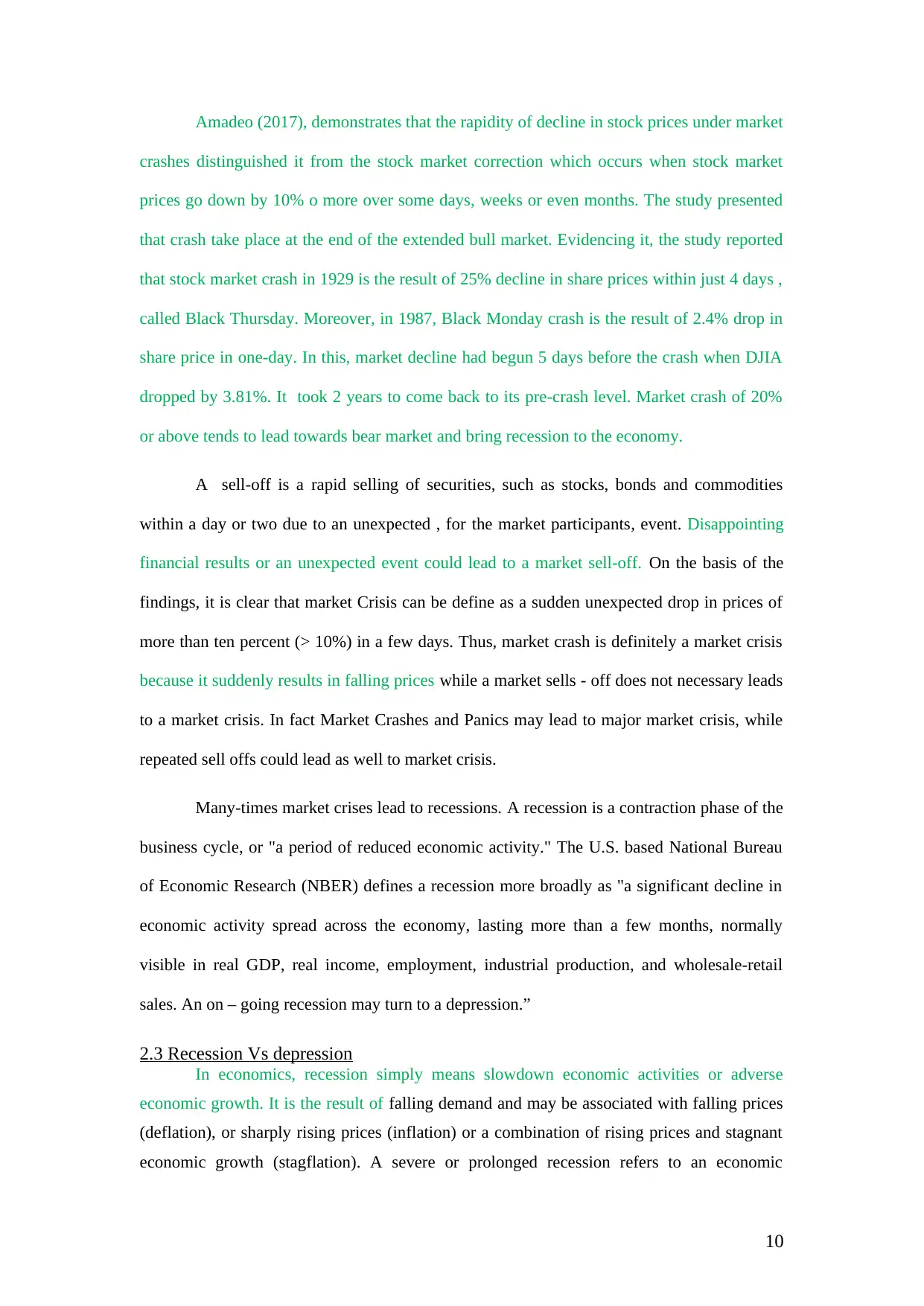
Amadeo (2017), demonstrates that the rapidity of decline in stock prices under market
crashes distinguished it from the stock market correction which occurs when stock market
prices go down by 10% o more over some days, weeks or even months. The study presented
that crash take place at the end of the extended bull market. Evidencing it, the study reported
that stock market crash in 1929 is the result of 25% decline in share prices within just 4 days ,
called Black Thursday. Moreover, in 1987, Black Monday crash is the result of 2.4% drop in
share price in one-day. In this, market decline had begun 5 days before the crash when DJIA
dropped by 3.81%. It took 2 years to come back to its pre-crash level. Market crash of 20%
or above tends to lead towards bear market and bring recession to the economy.
A sell-off is a rapid selling of securities, such as stocks, bonds and commodities
within a day or two due to an unexpected , for the market participants, event. Disappointing
financial results or an unexpected event could lead to a market sell-off. On the basis of the
findings, it is clear that market Crisis can be define as a sudden unexpected drop in prices of
more than ten percent (> 10%) in a few days. Thus, market crash is definitely a market crisis
because it suddenly results in falling prices while a market sells - off does not necessary leads
to a market crisis. In fact Market Crashes and Panics may lead to major market crisis, while
repeated sell offs could lead as well to market crisis.
Many-times market crises lead to recessions. A recession is a contraction phase of the
business cycle, or "a period of reduced economic activity." The U.S. based National Bureau
of Economic Research (NBER) defines a recession more broadly as "a significant decline in
economic activity spread across the economy, lasting more than a few months, normally
visible in real GDP, real income, employment, industrial production, and wholesale-retail
sales. An on – going recession may turn to a depression.”
2.3 Recession Vs depression
In economics, recession simply means slowdown economic activities or adverse
economic growth. It is the result of falling demand and may be associated with falling prices
(deflation), or sharply rising prices (inflation) or a combination of rising prices and stagnant
economic growth (stagflation). A severe or prolonged recession refers to an economic
10
crashes distinguished it from the stock market correction which occurs when stock market
prices go down by 10% o more over some days, weeks or even months. The study presented
that crash take place at the end of the extended bull market. Evidencing it, the study reported
that stock market crash in 1929 is the result of 25% decline in share prices within just 4 days ,
called Black Thursday. Moreover, in 1987, Black Monday crash is the result of 2.4% drop in
share price in one-day. In this, market decline had begun 5 days before the crash when DJIA
dropped by 3.81%. It took 2 years to come back to its pre-crash level. Market crash of 20%
or above tends to lead towards bear market and bring recession to the economy.
A sell-off is a rapid selling of securities, such as stocks, bonds and commodities
within a day or two due to an unexpected , for the market participants, event. Disappointing
financial results or an unexpected event could lead to a market sell-off. On the basis of the
findings, it is clear that market Crisis can be define as a sudden unexpected drop in prices of
more than ten percent (> 10%) in a few days. Thus, market crash is definitely a market crisis
because it suddenly results in falling prices while a market sells - off does not necessary leads
to a market crisis. In fact Market Crashes and Panics may lead to major market crisis, while
repeated sell offs could lead as well to market crisis.
Many-times market crises lead to recessions. A recession is a contraction phase of the
business cycle, or "a period of reduced economic activity." The U.S. based National Bureau
of Economic Research (NBER) defines a recession more broadly as "a significant decline in
economic activity spread across the economy, lasting more than a few months, normally
visible in real GDP, real income, employment, industrial production, and wholesale-retail
sales. An on – going recession may turn to a depression.”
2.3 Recession Vs depression
In economics, recession simply means slowdown economic activities or adverse
economic growth. It is the result of falling demand and may be associated with falling prices
(deflation), or sharply rising prices (inflation) or a combination of rising prices and stagnant
economic growth (stagflation). A severe or prolonged recession refers to an economic
10
Paraphrase This Document
Need a fresh take? Get an instant paraphrase of this document with our AI Paraphraser
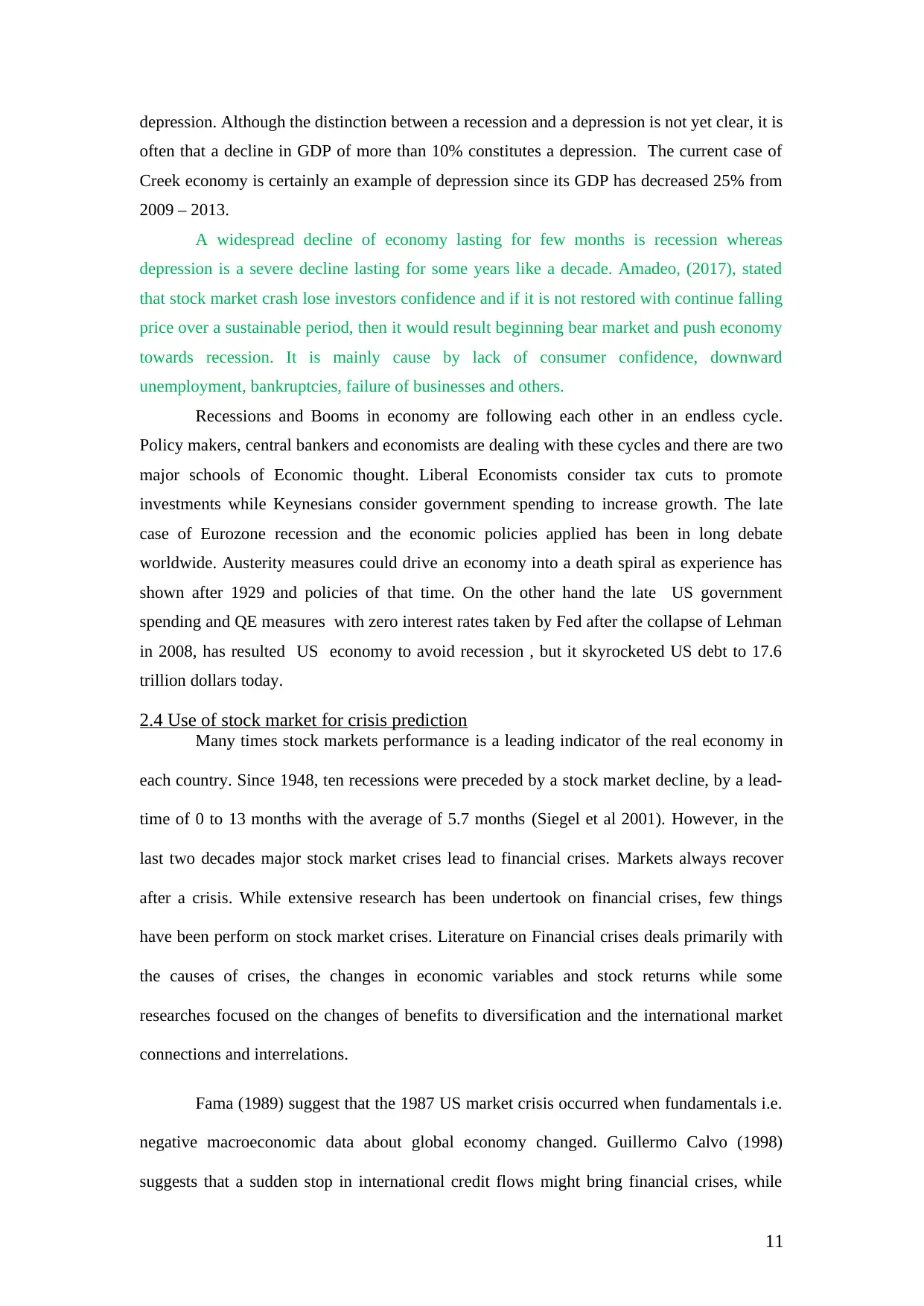
depression. Although the distinction between a recession and a depression is not yet clear, it is
often that a decline in GDP of more than 10% constitutes a depression. The current case of
Creek economy is certainly an example of depression since its GDP has decreased 25% from
2009 – 2013.
A widespread decline of economy lasting for few months is recession whereas
depression is a severe decline lasting for some years like a decade. Amadeo, (2017), stated
that stock market crash lose investors confidence and if it is not restored with continue falling
price over a sustainable period, then it would result beginning bear market and push economy
towards recession. It is mainly cause by lack of consumer confidence, downward
unemployment, bankruptcies, failure of businesses and others.
Recessions and Booms in economy are following each other in an endless cycle.
Policy makers, central bankers and economists are dealing with these cycles and there are two
major schools of Economic thought. Liberal Economists consider tax cuts to promote
investments while Keynesians consider government spending to increase growth. The late
case of Eurozone recession and the economic policies applied has been in long debate
worldwide. Austerity measures could drive an economy into a death spiral as experience has
shown after 1929 and policies of that time. On the other hand the late US government
spending and QE measures with zero interest rates taken by Fed after the collapse of Lehman
in 2008, has resulted US economy to avoid recession , but it skyrocketed US debt to 17.6
trillion dollars today.
2.4 Use of stock market for crisis prediction
Many times stock markets performance is a leading indicator of the real economy in
each country. Since 1948, ten recessions were preceded by a stock market decline, by a lead-
time of 0 to 13 months with the average of 5.7 months (Siegel et al 2001). However, in the
last two decades major stock market crises lead to financial crises. Markets always recover
after a crisis. While extensive research has been undertook on financial crises, few things
have been perform on stock market crises. Literature on Financial crises deals primarily with
the causes of crises, the changes in economic variables and stock returns while some
researches focused on the changes of benefits to diversification and the international market
connections and interrelations.
Fama (1989) suggest that the 1987 US market crisis occurred when fundamentals i.e.
negative macroeconomic data about global economy changed. Guillermo Calvo (1998)
suggests that a sudden stop in international credit flows might bring financial crises, while
11
often that a decline in GDP of more than 10% constitutes a depression. The current case of
Creek economy is certainly an example of depression since its GDP has decreased 25% from
2009 – 2013.
A widespread decline of economy lasting for few months is recession whereas
depression is a severe decline lasting for some years like a decade. Amadeo, (2017), stated
that stock market crash lose investors confidence and if it is not restored with continue falling
price over a sustainable period, then it would result beginning bear market and push economy
towards recession. It is mainly cause by lack of consumer confidence, downward
unemployment, bankruptcies, failure of businesses and others.
Recessions and Booms in economy are following each other in an endless cycle.
Policy makers, central bankers and economists are dealing with these cycles and there are two
major schools of Economic thought. Liberal Economists consider tax cuts to promote
investments while Keynesians consider government spending to increase growth. The late
case of Eurozone recession and the economic policies applied has been in long debate
worldwide. Austerity measures could drive an economy into a death spiral as experience has
shown after 1929 and policies of that time. On the other hand the late US government
spending and QE measures with zero interest rates taken by Fed after the collapse of Lehman
in 2008, has resulted US economy to avoid recession , but it skyrocketed US debt to 17.6
trillion dollars today.
2.4 Use of stock market for crisis prediction
Many times stock markets performance is a leading indicator of the real economy in
each country. Since 1948, ten recessions were preceded by a stock market decline, by a lead-
time of 0 to 13 months with the average of 5.7 months (Siegel et al 2001). However, in the
last two decades major stock market crises lead to financial crises. Markets always recover
after a crisis. While extensive research has been undertook on financial crises, few things
have been perform on stock market crises. Literature on Financial crises deals primarily with
the causes of crises, the changes in economic variables and stock returns while some
researches focused on the changes of benefits to diversification and the international market
connections and interrelations.
Fama (1989) suggest that the 1987 US market crisis occurred when fundamentals i.e.
negative macroeconomic data about global economy changed. Guillermo Calvo (1998)
suggests that a sudden stop in international credit flows might bring financial crises, while
11
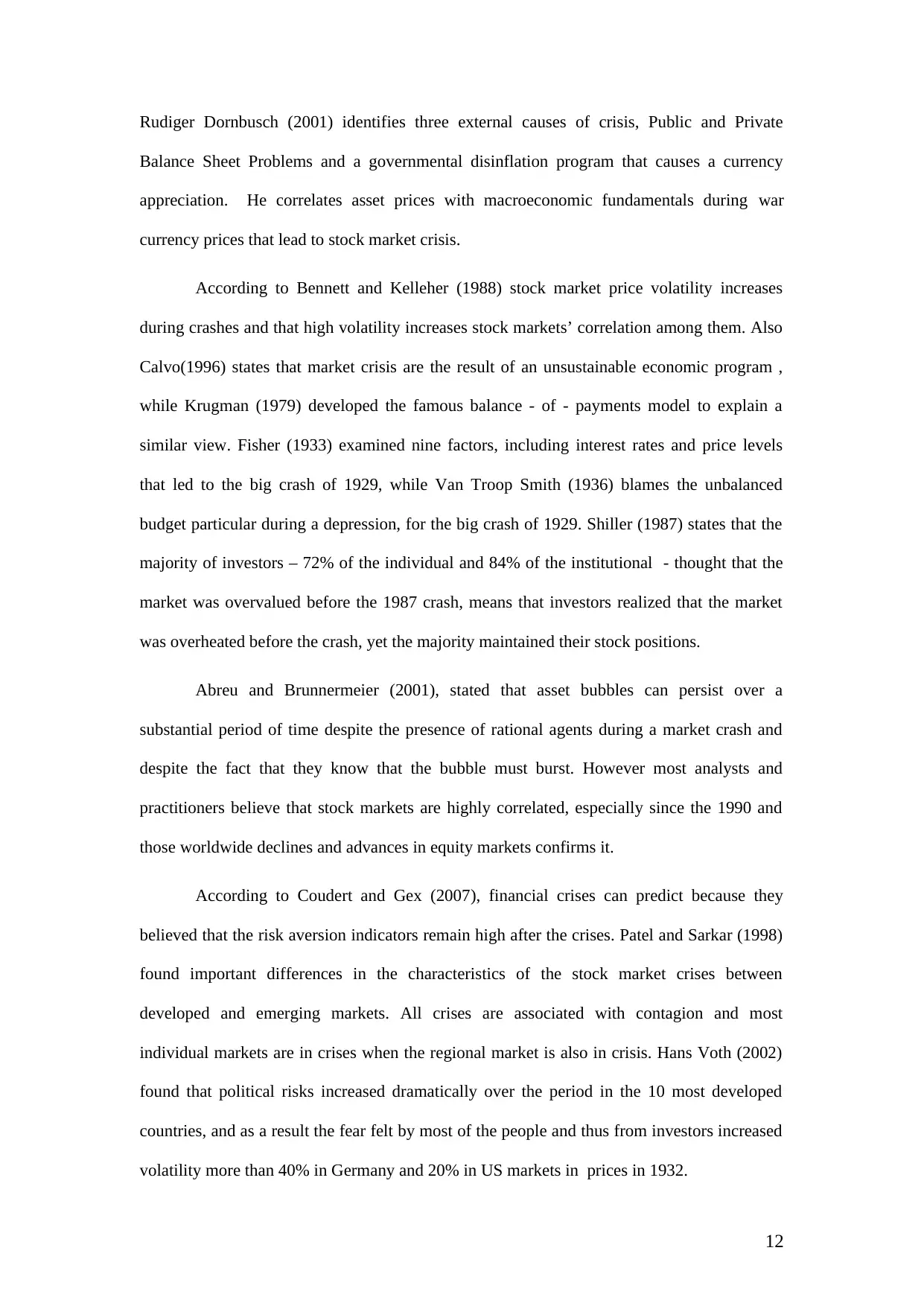
Rudiger Dornbusch (2001) identifies three external causes of crisis, Public and Private
Balance Sheet Problems and a governmental disinflation program that causes a currency
appreciation. He correlates asset prices with macroeconomic fundamentals during war
currency prices that lead to stock market crisis.
According to Bennett and Kelleher (1988) stock market price volatility increases
during crashes and that high volatility increases stock markets’ correlation among them. Also
Calvo(1996) states that market crisis are the result of an unsustainable economic program ,
while Krugman (1979) developed the famous balance - of - payments model to explain a
similar view. Fisher (1933) examined nine factors, including interest rates and price levels
that led to the big crash of 1929, while Van Troop Smith (1936) blames the unbalanced
budget particular during a depression, for the big crash of 1929. Shiller (1987) states that the
majority of investors – 72% of the individual and 84% of the institutional - thought that the
market was overvalued before the 1987 crash, means that investors realized that the market
was overheated before the crash, yet the majority maintained their stock positions.
Abreu and Brunnermeier (2001), stated that asset bubbles can persist over a
substantial period of time despite the presence of rational agents during a market crash and
despite the fact that they know that the bubble must burst. However most analysts and
practitioners believe that stock markets are highly correlated, especially since the 1990 and
those worldwide declines and advances in equity markets confirms it.
According to Coudert and Gex (2007), financial crises can predict because they
believed that the risk aversion indicators remain high after the crises. Patel and Sarkar (1998)
found important differences in the characteristics of the stock market crises between
developed and emerging markets. All crises are associated with contagion and most
individual markets are in crises when the regional market is also in crisis. Hans Voth (2002)
found that political risks increased dramatically over the period in the 10 most developed
countries, and as a result the fear felt by most of the people and thus from investors increased
volatility more than 40% in Germany and 20% in US markets in prices in 1932.
12
Balance Sheet Problems and a governmental disinflation program that causes a currency
appreciation. He correlates asset prices with macroeconomic fundamentals during war
currency prices that lead to stock market crisis.
According to Bennett and Kelleher (1988) stock market price volatility increases
during crashes and that high volatility increases stock markets’ correlation among them. Also
Calvo(1996) states that market crisis are the result of an unsustainable economic program ,
while Krugman (1979) developed the famous balance - of - payments model to explain a
similar view. Fisher (1933) examined nine factors, including interest rates and price levels
that led to the big crash of 1929, while Van Troop Smith (1936) blames the unbalanced
budget particular during a depression, for the big crash of 1929. Shiller (1987) states that the
majority of investors – 72% of the individual and 84% of the institutional - thought that the
market was overvalued before the 1987 crash, means that investors realized that the market
was overheated before the crash, yet the majority maintained their stock positions.
Abreu and Brunnermeier (2001), stated that asset bubbles can persist over a
substantial period of time despite the presence of rational agents during a market crash and
despite the fact that they know that the bubble must burst. However most analysts and
practitioners believe that stock markets are highly correlated, especially since the 1990 and
those worldwide declines and advances in equity markets confirms it.
According to Coudert and Gex (2007), financial crises can predict because they
believed that the risk aversion indicators remain high after the crises. Patel and Sarkar (1998)
found important differences in the characteristics of the stock market crises between
developed and emerging markets. All crises are associated with contagion and most
individual markets are in crises when the regional market is also in crisis. Hans Voth (2002)
found that political risks increased dramatically over the period in the 10 most developed
countries, and as a result the fear felt by most of the people and thus from investors increased
volatility more than 40% in Germany and 20% in US markets in prices in 1932.
12
⊘ This is a preview!⊘
Do you want full access?
Subscribe today to unlock all pages.

Trusted by 1+ million students worldwide
1 out of 54
Related Documents
Your All-in-One AI-Powered Toolkit for Academic Success.
+13062052269
info@desklib.com
Available 24*7 on WhatsApp / Email
![[object Object]](/_next/static/media/star-bottom.7253800d.svg)
Unlock your academic potential
Copyright © 2020–2025 A2Z Services. All Rights Reserved. Developed and managed by ZUCOL.




